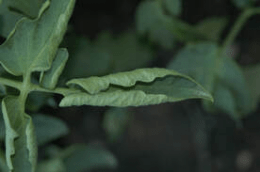If you are growing some awesome flowers or vegetables this summer, consider bringing them to your local county fair! For more information on presenting in Open class or 4-H entries, watch the video below.
By: Cassie Homan
If you are growing some awesome flowers or vegetables this summer, consider bringing them to your local county fair! For more information on presenting in Open class or 4-H entries, watch the video below.
By: Cassie Homan
 Every year we have calls from gardeners who have tomato plants with leaves that curl up. When tomato plants grow vigorously in mild, spring weather the top growth often exceeds the root development. When the first few days of warm, dry summer weather hit, the plant ‘realizes’ that it has a problem and needs to increase its root development. The plant tries to reduce its leaf area by rolling leaves. The leaves curl along the length of the leaf (leaflet) in an upward fashion. It is often accompanied by a thickening of the leaf giving it a leathery texture. Interestingly, leaf roll is worse on some varieties than others.
Every year we have calls from gardeners who have tomato plants with leaves that curl up. When tomato plants grow vigorously in mild, spring weather the top growth often exceeds the root development. When the first few days of warm, dry summer weather hit, the plant ‘realizes’ that it has a problem and needs to increase its root development. The plant tries to reduce its leaf area by rolling leaves. The leaves curl along the length of the leaf (leaflet) in an upward fashion. It is often accompanied by a thickening of the leaf giving it a leathery texture. Interestingly, leaf roll is worse on some varieties than others.
Though rolling usually occurs during the spring to summer shift period, it may also occur after a heavy cultivating or hoeing, a hard rain, waterlogged soil or any sudden change in weather. This leaf roll is a temporary condition that goes away after a week or so when the plant has a chance to acclimate, recover from injury, or the soil has a chance to dry out.
By: Cassie Homan
Summer is the perfect time to try new recipes and use all of the delicious vegetables form the garden! This video talks about growing a salsa garden and making some homemade salsa.
By: Cassie Homan
Cool season vegetables such as cabbage, broccoli, and cauliflower are prone to cabbage worms. These pests are hard to spot because they are often the same color of green as the plant leaves. Early control is important. Follow this link for more information on controlling cabbage worms.
color of green as the plant leaves. Early control is important. Follow this link for more information on controlling cabbage worms.
By: Cassie Homan
 This is the time of year that onions grow and develop rapidly. Regular watering and a light fertilization are helpful to maximize growth. If your soil tends to be alkaline, use ammonium sulfate (21-0-0) at the rate of ½ cup per 10 feet of row. Alternatively, you could use a lawn fertilizer such as a 29-5-5, 27-3-3 or anything similar, but only use 1/3 cup per 10 feet of row. Make sure the lawn fertilizer does not have a weed preventer or weed killer included. Sprinkle the fertilizer 2 to 3 inches alongside the row and water in. Do not fertilize after the onions start to bulb. Onions develop so that as much as 2/3 of the bulb remains out of the soil. This is normal and there is no need to cover the bulb with soil.
This is the time of year that onions grow and develop rapidly. Regular watering and a light fertilization are helpful to maximize growth. If your soil tends to be alkaline, use ammonium sulfate (21-0-0) at the rate of ½ cup per 10 feet of row. Alternatively, you could use a lawn fertilizer such as a 29-5-5, 27-3-3 or anything similar, but only use 1/3 cup per 10 feet of row. Make sure the lawn fertilizer does not have a weed preventer or weed killer included. Sprinkle the fertilizer 2 to 3 inches alongside the row and water in. Do not fertilize after the onions start to bulb. Onions develop so that as much as 2/3 of the bulb remains out of the soil. This is normal and there is no need to cover the bulb with soil.
By: Cassie Homan
 The month of May is a busy time for gardeners. Temperatures start warming up so we can plant more and more in the garden. There are also flower bed and lawn care tasks to take care of. For a full list of May tasks, visit our website.
The month of May is a busy time for gardeners. Temperatures start warming up so we can plant more and more in the garden. There are also flower bed and lawn care tasks to take care of. For a full list of May tasks, visit our website.
https://www.postrock.k-state.edu/lawn-garden/gardening_calendar/MayGardenCalendar.pdf
By: Cassie Homan
Lawn care can be confusing, but we are here to help. It is important to fertilize your lawn at the right time and with the correct amount of fertilizer. This video provides information on the best time to fertilize your lawn.
By: Cassie Homan